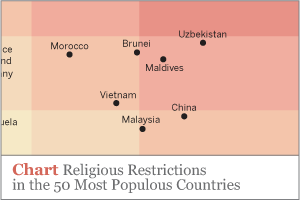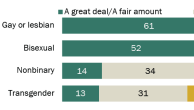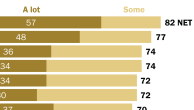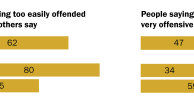An analysis of the two main ways in which religion is restricted – by government actions and by hostilities in society – reveals a number of patterns. Some are evident in a chart that compares these two measures for the 50 most populous countries as well as for the six countries with smaller populations that score very high on either index (Brunei, Eritrea, Israel, Maldives, Sri Lanka and Somalia).

As the chart shows, nearly all of the 50 most populous countries that are high on both measures of restrictions (upper right) are in Asia or the Middle East-North Africa region. Many of the restrictions in these countries are driven by groups pressing for the enshrinement of their interpretation of the majority faith, including through Shariah law in Muslim societies and through the Hindutva movement in India, which seeks to define India as a Hindu nation. (Additional examples of restrictions on religion in India can be found in the Methodology.)
A look at the lower left of the chart shows that the most populous European countries – including France, Germany, Italy, Poland, Ukraine and the United Kingdom – generally have moderate or low levels of government restrictions as well as of social hostilities. But fewer than a dozen of the world’s 50 most populous countries are in the low range on both measures. In the United States, where government restrictions on religion are relatively few, the level of social hostilities involving religion is near the bottom of the moderate range, somewhat higher than in a number of other large, Western countries, such as Canada, Brazil and Argentina. As previously noted, only one country, Saudi Arabia, is in the very high category on both the Government Restrictions Index and the Social Hostilities Index.

When all 198 countries and self-administering territories are plotted on a chart comparing their scores on the GRI and SHI, it is apparent that the two measures tend to move together. Running through the graph is the so-called regression line, which plots how scores on one index are related, on average, to scores on the other index. The upward slope of the line indicates that higher scores on one index generally are associated with higher scores on the other. Many countries are clustered in the lower left corner, showing that they are low on both types of restrictions. Though the remaining countries are fairly dispersed, most still follow the direction taken by the regression line, and very few are located in the upper left or lower right corners of the graph. This means that, in general, it is rare for countries that are high in social hostilities to be low on government restrictions, or for those that are high on government restrictions to be low in social hostilities.
Nevertheless, there are notable exceptions. In a few nations, government restrictions on religion are considerably higher than social hostilities. These countries – including China, Vietnam, Uzbekistan and Burma – tend to have either communist or authoritarian backgrounds, and religion is often viewed by the government as a potential threat to its authority.
Countries that follow the opposite pattern – that is, where social hostilities are considerably higher than government restrictions – tend to have large segments of the population that want to protect the special place of a particular religion, such as Buddhism in Sri Lanka, Hinduism in Nepal, Islam in Bangladesh and Orthodox Christianity in Ethiopia.




